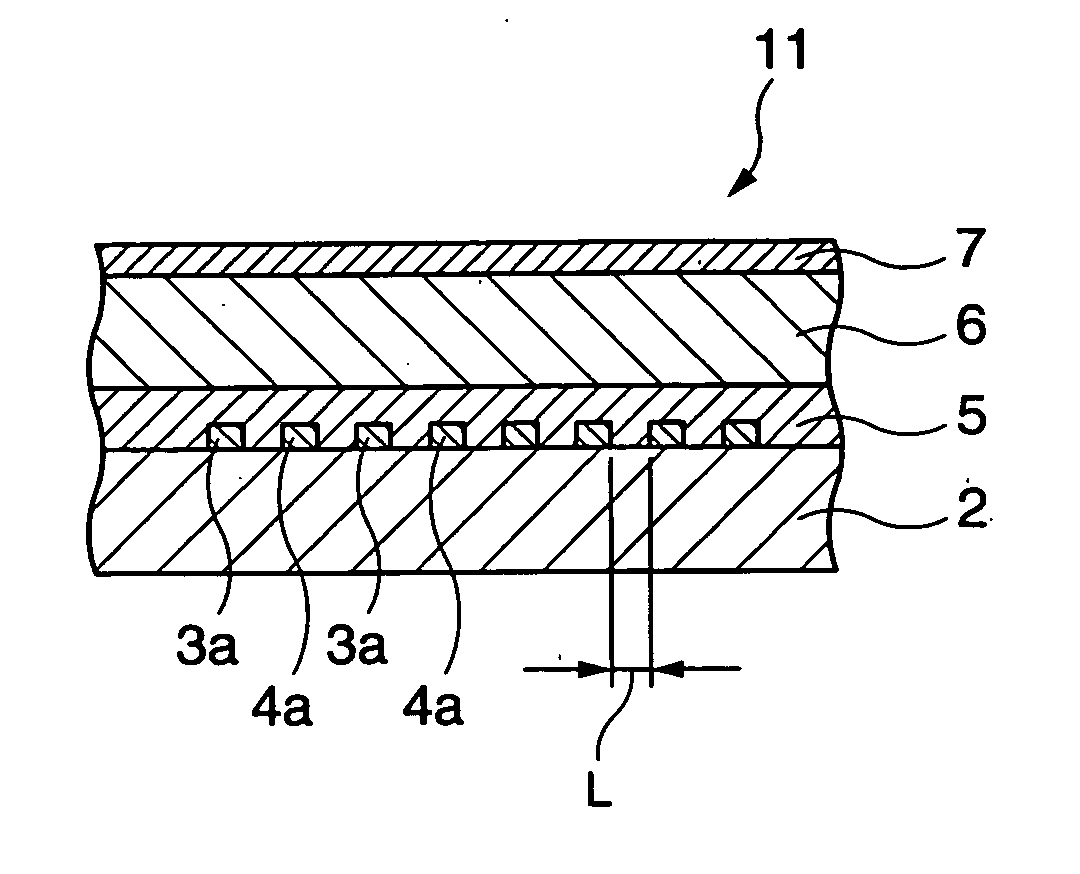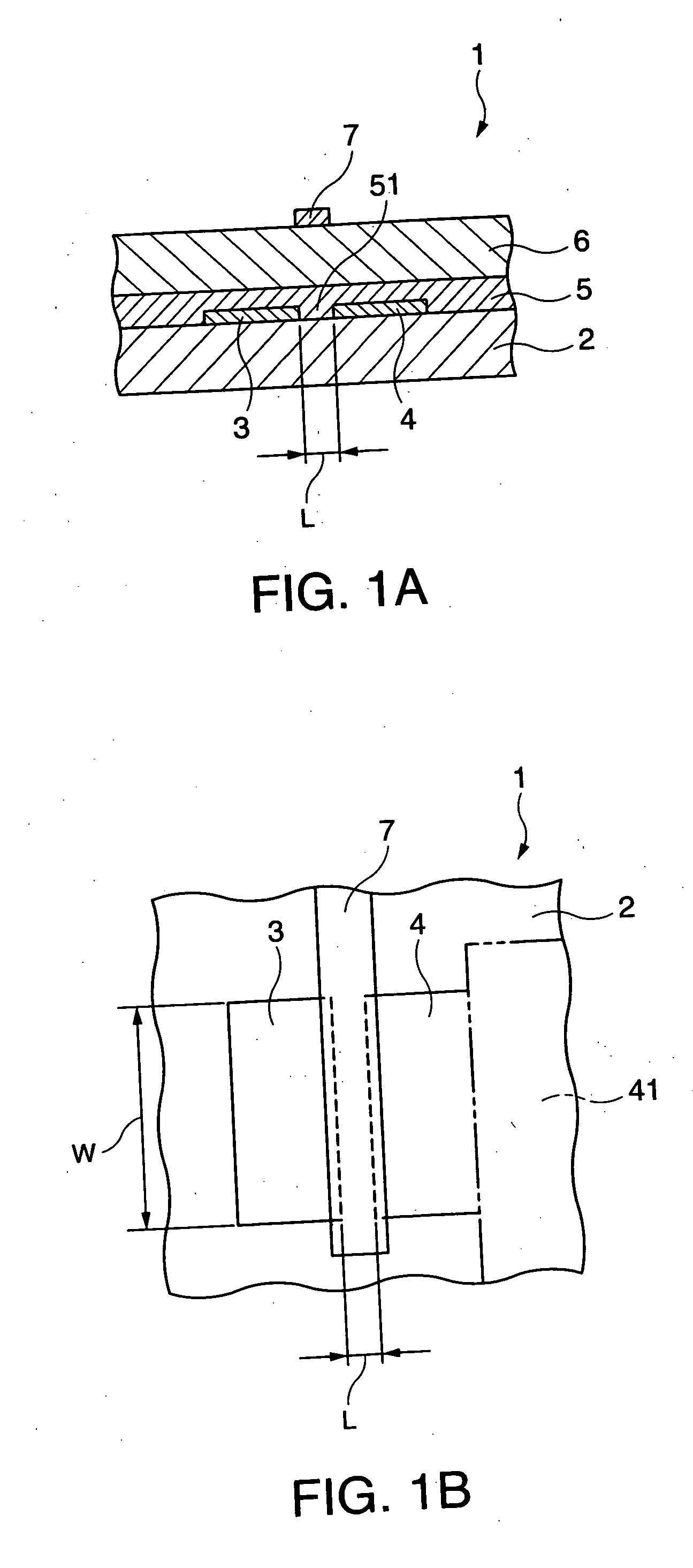Method of manufacturing a thin film transistor, thin film transistor, thin film transistor circuit, electronic device, and electronic apparatus
- Summary
- Abstract
- Description
- Claims
- Application Information
AI Technical Summary
Benefits of technology
Problems solved by technology
Method used
Image
Examples
example 1
[0218] Firstly, a glass substrate with a thickness of 1 mm is provided, and washed with water (cleaning fluid). Then, the glass substrate is dipped in an aqueous solution (25° C.) of distearyl dimethyl ammonium chloride (cationic surface-active agent) for 60 seconds. Thus, distearyl dimethyl ammonium chloride is absorbed on the surface of the glass substrate. Subsequently, the glass substrate is washed with water.
[0219] Then, the glass substrate is dipped in a Sn-Pd colloidal suspension (25° C.) for 60 seconds. Thus, Sn-Pd is absorbed on the surface of the glass substrate. Subsequently, the glass substrate is washed with water. Then, the glass substrate is dipped in an aqueous solution (25° C.) including HBF4 and glucose for 60 seconds. Thus, Sn is removed from the surface of the glass substrate to expose Pd on the surface of the glass substrate. Subsequently, the glass substrate is washed with water.
[0220] Then, the glass substrate is dipped in a Ni plating solution (80° C., pH 8...
example 2 through 9
[0224] The thin film transistor shown in FIGS. 1A and 1B is manufactured similarly to the example 1 while changing the nature of the reducing agent, the nature of the pH adjuster, and presence or absence and / or the nature of the plasma process as shown in TABLE 1.
TABLE 1Reducing agentpH adjusterPlasma processExample 1HydrazineAmmonium sulfideAtmospheric pressureoxygen plasmaExample 2AmmoniumAmmonium sulfideAtmospheric pressurehypophosphiteoxygen plasmaExample 3Hydrazine + AmmoniumAmmonium sulfideAtmospheric pressurehypophosphite*1oxygen plasmaExample 4HydrazineAmmonia waterAtmospheric pressureoxygen plasmaExample 5HydrazineTrimethylAtmospheric pressureammonium hydrideoxygen plasmaExample 6HydrazineAmmonium sulfide + TrimethylAtmospheric pressureammonium hydride*2oxygen plasmaExample 7HydrazineAmmonium sulfideAtmospheric pressure ArplasmaExample 8HydrazineAmmonium sulfideAtmospheric pressureCF4 plasmaExample 7HydrazineAmmonium sulfideNoExample 8AmmoniumAmmonium sulfideNohypophosphi...
example 10
[0225] Firstly, a polyimide substrate with a thickness of 35 μm is provided, and washed with water (cleaning fluid). Subsequently, the polyimide substrate is dipped in an aqueous solution (25° C.) including CrO3 and sulfuric acid for 60 seconds, and then dipped in an aqueous solution (25° C.) of ammonium sulfite hydrate 60 seconds as a pre-process.
[0226] And then, a resist layer having a pattern corresponding to the area other than the area in which the source electrode and the drain electrode are to be formed is formed on the polyimide substrate by a lithography process. Note that “PMERP-NZ30” produced by Tokyo Ohka Kogyo Co., Ltd is used as the resist material. Then, the plated film is formed similarly to the example 1. Note that the distance (the channel length L) between the source electrode and the drain electrode is arranged to be 20 μm, and the channel width W is arranged to be 1 mm.
[0227] Then, after removing the resist layer using the resist remover, the polyimide substra...
PUM
| Property | Measurement | Unit |
|---|---|---|
| Pressure | aaaaa | aaaaa |
| Electrical conductivity | aaaaa | aaaaa |
| Adhesivity | aaaaa | aaaaa |
Abstract
Description
Claims
Application Information
 Login to View More
Login to View More - R&D
- Intellectual Property
- Life Sciences
- Materials
- Tech Scout
- Unparalleled Data Quality
- Higher Quality Content
- 60% Fewer Hallucinations
Browse by: Latest US Patents, China's latest patents, Technical Efficacy Thesaurus, Application Domain, Technology Topic, Popular Technical Reports.
© 2025 PatSnap. All rights reserved.Legal|Privacy policy|Modern Slavery Act Transparency Statement|Sitemap|About US| Contact US: help@patsnap.com



